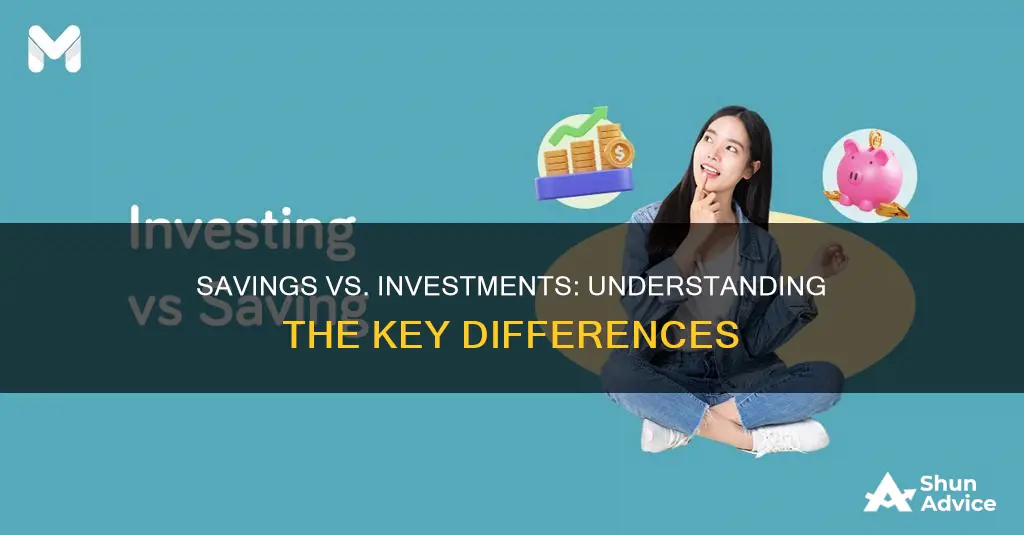
Saving and investing are both important concepts for building a sound financial future, but they are not the same thing. Saving is putting money aside for future use, such as an emergency fund or short-term goals like a vacation or buying a gadget. It usually involves low-risk accounts like savings accounts or certificates of deposit (CDs) that earn a low interest rate. On the other hand, investing is a way to grow your money over time by putting it into financial instruments like stocks, bonds, or mutual funds. It typically comes with a higher risk of losing money but also offers the potential for higher returns. Understanding the differences between saving and investing is crucial for making informed financial decisions and achieving both short-term and long-term goals.
| Characteristics | Values |
|---|---|
| Risk | Saving: Low risk of losing value |
| Investing: Higher risk of losing value | |
| Returns | Saving: Low returns |
| Investing: Potential for higher returns | |
| Time horizon | Saving: Short-term |
| Investing: Long-term | |
| Liquidity | Saving: High liquidity |
| Investing: Low liquidity | |
| Financial goals | Saving: Short-term goals, e.g. emergency fund, vacation |
| Investing: Long-term goals, e.g. retirement, children's education | |
| Account types | Saving: Savings account, money market account, certificate of deposit (CD) |
| Investing: Stocks, bonds, mutual funds, ETFs |
What You'll Learn

Risk and reward
Saving: Lower Risk, Lower Reward
- Lower Risk: Saving typically entails very little risk. Savings accounts, money market accounts, and certificates of deposit (CDs) are considered safe options as they are often insured by financial institutions or government entities, such as the Federal Deposit Insurance Corporation (FDIC) in the United States. This insurance protects your deposits up to a certain limit, ensuring that your money is secure even if the bank fails.
- Lower Reward: While saving offers stability, it generally provides lower financial returns. The interest rates on savings accounts tend to be low, and your money may lose purchasing power over time due to inflation. As a result, the value of your savings may not keep up with the rising cost of living.
Investing: Higher Risk, Higher Reward
- Higher Risk: Investing comes with a greater risk of losing money. Unlike insured deposits, investments such as securities, stocks, bonds, mutual funds, and exchange-traded funds (ETFs) are not federally insured. The value of these investments can fluctuate, and there is no guarantee of positive returns. You may lose some or all of your initial investment, especially in the short term.
- Higher Reward: Investing offers the potential for higher financial returns compared to saving. By taking on more risk, you create an opportunity for greater gains. Over time, investing in a diversified portfolio of stocks, for example, has historically yielded higher returns than simply keeping your money in a savings account.
Balancing Risk and Reward
- Time Horizon: The time horizon plays a crucial role in balancing risk and reward. Saving is generally recommended for short-term financial goals, such as emergency funds, upcoming purchases, or expenses within the next few years. On the other hand, investing is more suitable for long-term goals, like retirement planning or saving for a child's education. The longer time horizon in investing allows for potential downturns in the market and provides the opportunity for your investments to recover and grow.
- Risk Tolerance: Your personal risk tolerance also factors into the decision to save or invest. If you are averse to risk and prefer the security of having accessible funds, saving may be a better option. However, if you are comfortable with taking on more risk and can withstand potential losses, investing may be more appealing.
- Diversification: Diversification is a strategy to manage risk and maximize returns. By diversifying your investments across different asset classes, industries, and companies, you reduce the impact of any single investment loss. This strategy can help you achieve a more balanced portfolio and potentially increase your overall returns.
Equity Saving Schemes: A Guide to Investing Wisely
You may want to see also

Liquidity
Savings accounts generally offer high liquidity, meaning you can easily withdraw your money at any time without incurring penalties. This makes savings ideal for short-term financial goals and unexpected expenses. For example, if you're saving for a new car, a vacation, or building an emergency fund, a savings account provides the flexibility to access your money whenever needed. The downside of high liquidity in savings is the opportunity cost of missing out on potential investment returns.
Investments, on the other hand, typically have lower liquidity compared to savings. While you can sell investments and access your money, it may take longer, and you may incur fees or taxes. Investments are designed for longer-term financial goals, such as retirement or saving for a child's education. They are meant to be held for extended periods to maximize returns. Withdrawing early from an investment may result in penalties or taxes, and there is a risk of losing money if the investment is not held for the intended duration.
It's important to note that different types of investments have varying levels of liquidity. For instance, stocks, bonds, and ETFs are generally more liquid than physical assets like real estate. Additionally, some investment accounts, such as retirement accounts, may have specific restrictions on early withdrawals.
When deciding between saving and investing, it's crucial to consider your financial goals and time horizon. If you need frequent access to your money or are saving for short-term goals, then the high liquidity of savings accounts is more suitable. However, if you are planning for the long term and can afford to have your money tied up, investing offers the potential for higher returns.
Ultimately, both saving and investing play important roles in financial planning. Savings provide liquidity and accessibility, making them ideal for short-term needs. In contrast, investments are less liquid but offer the potential for higher returns over the long term. Striking a balance between the two can help you effectively manage your finances and achieve your financial objectives.
Savings vs. Investments: What's the Difference?
You may want to see also

Time horizons
Saving is generally recommended for short-term financial goals. This could include saving for a new phone, laptop, or a vacation. It is also ideal for emergency funds, unexpected expenses, or upcoming purchases that you plan to make within the next three to five years. For example, if you are saving for a down payment on a house and plan to buy within seven years or less, saving is a more suitable option than investing.
On the other hand, investing is typically associated with longer-term goals. This could include saving for college funds, retirement, or leaving a financial legacy for your family. Investing usually involves a longer-term horizon, often many years, and is suitable for goals that are at least three to five years away. For instance, if you are saving for a house and don't plan to buy for more than ten years, investing may be a better option.
The time horizon is crucial because it determines your risk tolerance and the potential growth of your money. With saving, you are often opting for safer, more liquid assets, such as savings accounts, money market accounts, or certificates of deposit (CDs). These options offer low returns but provide easy access to your funds with minimal risk of loss.
Investing, on the other hand, involves taking on more risk with the potential for higher returns. The longer your time horizon, the more risk you can typically take on as you have more time to recover from any short-term losses. Investing in the stock market or mutual funds, for example, may be suitable for longer-term goals as it allows you to ride out the ups and downs of the market.
In summary, the time horizon is an essential consideration when deciding between saving and investing. Saving is ideal for short-term goals, providing easy access to funds with minimal risk. Investing is better suited to longer-term goals, offering the potential for higher returns but with greater risk and less liquidity.
Monetary Policy: Investing and Saving Explained
You may want to see also

Inflation
To safeguard against inflation, investors often seek out investment options. The impact of inflation on investments depends on the type of investment. For investments with a set annual return, like regular bonds or bank certificates of deposit, inflation can hurt performance. On the other hand, investments like stocks, mutual funds, and certain commodities such as precious metals, oil, and agricultural goods, can potentially keep pace with inflation better than fixed-return options. Additionally, some investments are indexed for inflation risk, such as Treasury Inflation-Protected Securities (TIPS), which adjust their interest payouts based on changes in the Consumer Price Index (CPI).
It is important to note that there is no sure way to protect your money from the effects of inflation. However, by diversifying your portfolio across asset classes and considering inflation risk, you can help minimize the impact of inflation on your savings and long-term financial plans.
SSS Workers Investment and Savings: A Guide to the Program
You may want to see also

Financial goals
Setting financial goals is a crucial step towards achieving financial security and stability. Here are some detailed instructions and considerations to help you establish effective financial goals:
Identify Short-Term, Mid-Term, and Long-Term Goals:
- Short-term goals: These are achievable within a year and typically involve smaller purchases or expenses, such as buying a desired item, paying for a vacation, or setting up an emergency fund.
- Mid-term goals: These goals can be achieved in the short term but may take up to five years. Examples include paying off credit card debts or loans and saving for a down payment on a house.
- Long-term goals: These goals take longer than five years to accomplish and often require more significant financial commitments. Examples include paying off a mortgage or student loans, and funding retirement plans.
Assess Your Current Financial Situation:
Before setting financial goals, it's essential to evaluate your current economic status. This involves understanding your income, expenses, assets, liabilities, debts, savings, and investments. By analysing these aspects, you can identify areas for improvement and explore new opportunities.
Make Goals Specific, Measurable, Achievable, Relevant, and Time-Bound (SMART):
Adhering to the SMART criteria will ensure your financial objectives are clear and realistic. Each goal should be specific, quantifiable, realistic, pertinent to your dreams and values, and have a defined timeline. For example, a specific goal might be to save a certain amount for a down payment on a house within the next three years.
Prioritise Goals Based on Importance and Urgency:
Not all financial goals carry the same level of urgency or importance. Prioritise your goals by creating lists based on their significance and timeliness. This will help you allocate your resources effectively and focus on the most critical objectives.
Strategies for Achieving Your Financial Goals:
- Develop a budget: Create a budget to track your income and expenses, identify savings opportunities, and ensure you're setting aside money for your goals.
- Automate savings and investments: Set up automatic transfers from your bank account to your investment and savings accounts. This helps resist the temptation to spend money elsewhere and ensures consistent contributions towards your goals.
- Reduce expenses and increase income: Regularly review your spending to find areas where you can save. Additionally, consider ways to boost your income through side projects, freelance work, or career advancement.
- Stay flexible and adjust as needed: Life is unpredictable, so be prepared to adapt your financial plans and goals as your personal or financial circumstances change.
- Monitor your progress regularly: Keep track of your progress towards each financial goal. Update your budget, review your investment and savings accounts, and evaluate whether you're on schedule to reach your goals.
Remember, achieving financial goals requires commitment, discipline, and flexibility. Setting clear goals, prioritising them, and implementing strategies to reach them will help you take control of your finances and work towards a secure and prosperous future.
Transferring Funds: Ally Invest to Ally Savings
You may want to see also
Frequently asked questions
Saving is putting money aside for future use, usually in a savings account. It is a good strategy if you need your money in a short time, but it may not be the best option if you want to grow your money.
Saving is a safe option as you will not lose money, and you can access your funds quickly without any financial penalty. It is also a good strategy if you need to fund a goal yourself and don't need your money to grow significantly.
Savings accounts may not offer the highest potential yield, and if the savings interest rate doesn't keep up with the average cost of living, you will lose some of your money's buying power over time.
Investing is the process of buying an investment product with the expectation that your money will earn a higher return over time. It is a good strategy for achieving longer-term financial goals, but it comes with the risk of losing money.
Investing can help you achieve your financial goals faster than saving alone, and it may be the only way to keep pace with inflation. It also allows you to participate in global financial markets and benefit from the success of profitable companies.
Investing comes with the risk of losing money, and there may be penalties or taxes for withdrawing investment gains early. It can also be more complex and require more research than saving.







